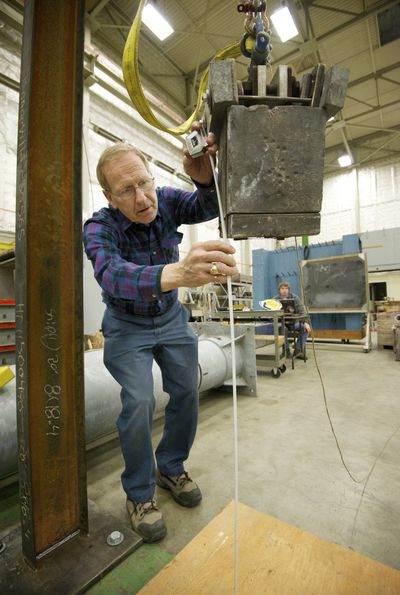Vancouver lab creates lightning to test power grid

VANCOUVER, Wash. – Jeff Hildreth gave the go-ahead order, then watched as a small red light started blinking. He waited.
A warning sounded about a minute later. Soon came a brilliant flash of light, a crack like a gunshot, then silence.
Lightning can be hard to come by in Southwest Washington. But the Bonneville Power Administration can create lightning on demand in a little-known laboratory at Vancouver’s Ross Complex substation.
It’s one way the federal power marketing agency can make sure that some 15,000 miles of power lines on the regional grid won’t succumb to the forces of nature.
“Believe it or not, lightning strikes power system equipment all the time,” said Hildreth, a BPA electrical engineer. “The power system equipment has to be able to withstand that, and people want their lights to stay on.”
The lab, built in the 1970s, uses high-octane equipment to push various power grid components to their limits. To conjure up lightning, workers use a column-shaped surge generator capable of pumping out 2 million volts of electricity.
The energy discharges from the top of the generator. During a recent demonstration, the current traveled down a ribbon cable attached to the device and zapped an open power switch, like one you’d commonly find at a substation.
But rather than jump across the gap in the switch, the lightning flashed toward the floor. In other words, the opening stopped the electricity from continuing on its path, just as it’s designed to do.
Engineers test the strength and function of all kinds of equipment using the lightning generator, Hildreth said. But a much more common test looks for a phenomenon that can happen in any large transmission line.
When electricity passes through a high-voltage power line, not all of it stays in the line. Discharges in the form of buzzing, radio interference and a visible glow often occur. That discharge, known as “corona,” is what engineers try to prevent.
“It’s an undesirable side effect of high voltage,” Hildreth said.
Corona can damage certain parts of a power system, and it wastes energy that could otherwise be sold and used in the region, Hildreth said. It’s a tiny fraction of the overall load lost – generally less than one-tenth of one percent, according to BPA – but it can add up, he said.
The high-voltage lab isn’t the only facility at Ross Complex capable of putting on a show. In another building a short walk away, the mechanical lab can light up electrical insulators with tens of thousands of volts.
In the mechanical lab, engineers stretch the physical limitations of various equipment types. One recent project tested the strength of metal clips designed to keep workers from falling off of large utility towers. Once properly evaluated, BPA could begin installing the clips within a few months, mechanical engineer Mick Johnson said.